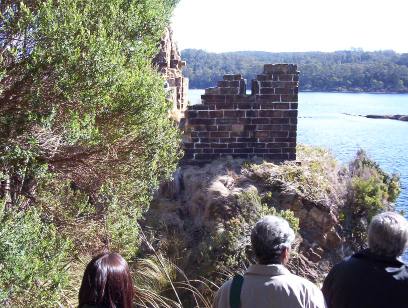


The township of Strahan wasn't really founded until 1877. Prior to that the small port had been variously known as Long Bay and Regatta Point but in 1877 it became a vital port for the tin mines at Mt Heemskirk. It was named after Major George Strahan who was the Governor of Tasmania from 1881-86. The town was officially proclaimed in 1892, two years after the government had constructed a railway from the booming mining town of Zeehan. A railway line from Queenstown was opened in 1899. Thus, at its peak, during this mining boom, Strahan had a population of over 2,000 people and was the second busiest port in Tasmania.
The town continued to prosper as a major port until the 1950s and 1960s. In 1960 the rail link to Zeehan was closed down. Three years later the same fate befell the Queenstown rail link (there is still a remnant of the railway line on the shore near Regatta Point) and in 1969 Mount Lyell Co. started to send its ore by rail to Burnie. The result was that while its importance as a port declined the town became a major tourist centre.
The major change in the area occurred when the Tasmanian Government decided it wanted to dam the Gordon River.
In 1983 the Federal Government, after an extended period of environmental activism, decided that the Gordon-below-Franklin Dam proposed by the Tasmanian Hydro-Electricity Authority would be stopped and that the whole area, including the Aboriginal art in Fraser Cave and the white waters of the dangerous Franklin River, would be preserved under a World Heritage order. The whole area is now known as the Franklin Lower Gordon Wild Rivers National Park and it attracts tourists from around the world.
The British invented this place as the ultimate penal colony. Named after Governor Lachlan Macquarie this 50 kilometres long harbour opens to the sea through the narrow, eddying waters of Hell's Gates and receives the waters of the King and Gordon Rivers.
The first European to explore Macquarie Harbour was James Kelly who, with four companions, entered Hells Gate in December 1815.
It is interesting to note that when Kelly entered Hells Gate he wrote 'The whole face of the coast was on fire, lucky circumstance for us. The smoke was so thick we could not see a hundred yards ahead of the boat. On pulling into the 'Narrows' at the small entrance island, we heard a large number of natives shouting and making a great noise as if they were hunting kangaroo.'
These Aborigines had lived in the area for at least 20,000 years. Tragically by about 1830 there were none left in the area although, in recent times, the discovery of Kutikina Cave near the Franklin River, has offered a rare insight into their lifestyle 15,000 years ago.
James Kelly and his group spent three days exploring the huge 285 square kilometre harbour and it was on the basis of their descriptions of the vast stands of trees that, within a year, timber cutters had entered the harbour and were cutting down the magnificent huon pines. It was probably as early as 1816 that the brig Sophia passed through Hells Gates. This was extremely dangerous as the entrance to the harbour wasn't properly surveyed until 1819.
It was the huon pine, a superb fine-grained wood which was ideal for shipbuilding, which brought the first Europeans to the harbour. It was huon pine which was also the cause for the establishment of a penal colony at Sarah Island in 1821. At that point a signal station was established on Cape Sorell to ensure safe traffic through Hells Gates.
The penal colony, known everywhere as one of the most appalling and cruel of all the convict stations, operated from Sarah Island. It finally closed down in 1833 when the recidivists were all removed to Port Arthur on the east coast. The convicts worked on a nearby coal seam and rowed across the harbour each day to cut down the large stands of Huon pine which edged the waters.
It was from here that the notorious convict Alexander Pearce attempted to escape in 1822. In a bizarre footnote to the history of the region Pearce and seven other convicts attempted to cross the island to Hobart where they hoped they could catch a merchant ship and escape to some ill-defined freedom.
They lost their way and in the ensuing weeks all of the escapees disappeared except for Pearce. When he was recaptured unproven accusations of cannibalism were made against him. The following year Pearce escaped again accompanied by another convict, Thomas Cox. Once again Pearce found himself without food and, to solve the problem, he killed and ate Cox. When he was finally recaptured Pearce admitted to eating Cox and confessed to cannibalism during his first escape. He was subsequently executed in Hobart.
.
Five Star Review
![]() A
lovely location with stunning walks and close to many fine beaches.
A
lovely location with stunning walks and close to many fine beaches.